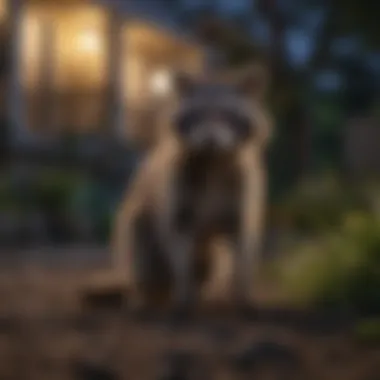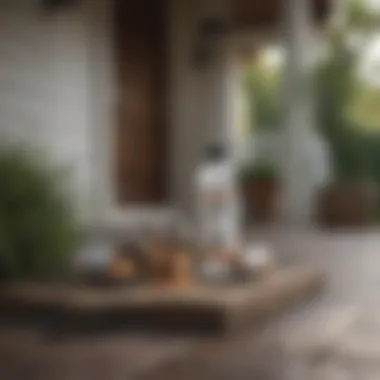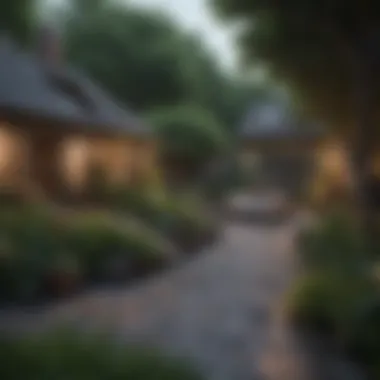Effective Strategies to Discourage Raccoons


Intro
Raccoons are adaptable creatures, often seen as clever nuisances in urban and suburban settings. Understanding their behavior and tendencies is crucial for homeowners who wish to prevent these animals from entering their properties. This guide examines various strategies aimed at deterring raccoons, emphasizing methods that respect both personal property and the local ecosystem. Homeowners can adopt practical techniques, evaluate their current environments, and create conditions that are less conducive to raccoon visits.
Understanding Raccoon Behavior
To effectively discourage raccoons, one must first grasp their habits and preferences. Raccoons are nocturnal animals, meaning they are primarily active during the night. They are opportunistic feeders, inclined to scavenge for food wherever they can find it. This scavenging behavior often leads them to residential areas where food sources, such as trash and pet food, are easily accessible.
"Raccoons' dexterity allows them to open containers and access food, which reinforces their attempts to inhabit areas with human activity."
Homeowners should consider that raccoons are creatures of habit. If they discover a reliable source of food or shelter, they are likely to return. By addressing the specific factors that attract raccoons, effective deterrence becomes possible.
Preventive Measures
Successful deterrence stems from a combination of habitat modification, food management, and the use of certain deterrent products.
Habitat Modification
Raccoons seek shelter to nest and hide from dangers. Minimizing their options can push them to find alternative habitats. To modify their environment:
- Secure Garbage Cans: Use raccoon-proof containers or bins with tight-fitting lids to make accessing food more difficult.
- Remove Hiding Places: Clear away debris, wood piles, or overgrown shrubs that might provide shelter.
- Maintain Yard Cleanliness: Regularly clean up fallen fruit, birdseed spills, or pet food left outside, as these can attract raccoons.
Food Management
Taking proactive steps regarding food sources is crucial. Homeowners should:
- Feed Pets Indoors: Always bring pet food inside at night to avoid attracting raccoons.
- Use Bird Feeders Wisely: Consider raccoon-proof feeders and avoid leaving food out overnight.
- Compost Correctly: Be cautious with compost bins, as they can attract raccoons if not managed properly.
Deterrent Products
Several products exist on the market aimed at discouraging raccoons. These may include:
- Motion-activated Sprinklers: These sprinklers can startle raccoons and other wildlife, making your property less appealing.
- Ultrasonic Deterrents: These devices emit sounds that are unpleasant to raccoons but inaudible to humans.
- Natural Repellents: Some homeowners have reported success using substances like cayenne pepper and ammonia around their property edges.
Finale
Deterring raccoons from residential properties requires an integrated approach. Homeowners must understand the behavior of raccoons and take actionable steps to modify their environments. By removing food sources and nesting options and utilizing deterrents, it is possible to maintain a harmonious balance with local wildlife while protecting one's property from unwanted visitors.
For further detailed exploration on raccoons, you can visit Wikipedia or Britannica.
Understanding Raccoon Behavior
Understanding raccoon behavior is critical for homeowners aiming to discourage these animals from invading their property. Knowledge of how raccoons think and act helps in creating effective strategies to modify environments in ways that deter them. Raccoons are intelligent creatures, known for their adaptability and resourcefulness. This insight allows homeowners to anticipate potential issues and implement tailored solutions.
Raccoon Habitats
Raccoons can thrive in various habitats, including forests, urban areas, and wetlands. They often take advantage of human settlements, where food and shelter are plentiful. When designing properties, it is essential to be aware of how nearby environments can attract raccoons. Observing local geographics can reveal entrances, such as gaps under decks or eaves, providing access to your yard. Adjusting your landscaping by trimming bushes or eliminating overhanging branches can reduce these entry points.
Feeding Patterns and Preferences
Raccoons are primarily omnivorous and can eat a broad range of foods, including fruits, vegetables, pet food, and garbage. Their feeding patterns may vary with the seasons, especially during winter when they are foraging for sustenance. In many cases, raccoons will be drawn to the odors of easy food sources left outside. To limit attractants, homeowners should take proactive steps such as stowing away pet food, securing compost bins, and covering trash cans firmly. Being vigilant about food sources can significantly decrease the chances of attracting raccoons.
Social Structure and Communication
Raccoons usually exhibit a loose social structure, mainly gathering in family groups. They communicate through vocalizations and physical displays, signaling their presence to other raccoons. Understanding these behaviors is helpful in assessing how they might react to disturbances in their territory. For instance, loud noises from motion-activated devices can disrupt raccoon interactions and dissuade them from returning. Homeowners can thus use knowledge of social dynamics to enhance their deterrent strategies.
"Effective raccoon deterrence begins with understanding the animals. By recognizing their habits and social structures, homeowners can take informed steps to keep their property safe."


Using these insights into raccoon behavior allows for a more nuanced approach to discouraging these pests. It is not just about eliminating attractants; it involves creating an environment that raccoons simply do not find appealing.
Identifying Raccoon Problems
Understanding raccoon problems is critical for homeowners. Raccoons are adaptable creatures that often invade residential areas in search of food and shelter. Identifying signs of their presence and assessing the damage they cause helps in taking preventive measures. Recognizing the severity of a raccoon issue allows for timely interventions, potentially saving property and reducing hazards in the living space. Moreover, awareness of local wildlife laws and regulations becomes paramount, guiding homeowners in their approach to dealing with these animals.
Signs of Raccoon Activity
Identifying signs of raccoon activity is a fundamental step in managing these critters. Here are key indicators to look for:
- Tracks or Prints: Raccoons have distinct paw prints, roughly 2-4 inches long. Their front feet have five toes, while the hind feet resemble those of small bears. Look for these prints in soft soil or mud.
- Scat: Raccoon droppings are often cylindrical and can contain seeds, fur, or fragments of food. Finding scat near garbage bins or flower beds may indicate recent visits.
- Noise: Raccoons are nocturnal and can be noisy, especially when foraging. Sounds of rustling, scratching, or chattering at night could signify their presence.
- Damaged Landscaping: Raccoons may dig in gardens or overturn plants while searching for food, particularly looking for grubs and insects. Signs of disturbances, such as uprooted plants, reflect their activity.
Vigilance in regularly monitoring these signs can help homeowners act swiftly. It's important to address raccoon presence before they establish a pattern of behavior on the property.
Damage Assessment
Once signs of raccoons are identified, an assessment of damage is essential. This involves evaluating both physical damage to property and potential impacts on health. Consider the following aspects:
- Structure Damage: Raccoons are adept climbers and may enter through attics or roofs. Look for broken vents, dislodged shingles, or gnaw marks on wooden structures. Any entry points should be sealed promptly to prevent further access.
- Trash and Debris: Examine garbage bins and compost areas for signs of ransacking. Raccoons are notorious for scavenging, and their activity can lead to significant messes, requiring cleanup and potential replacements of bins.
- Health Risks: Presence of raccoons may pose health risks, as they can transmit diseases such as raccoon roundworm. Assess any areas where raccoons may have nested, as these could have health implications for pets and humans.
The importance of thorough damage assessment cannot be overstated. Early recognition and repair of damage can deter further invasions and preserve the integrity of your property.
By being proactive in identifying signs and assessing the damage, homeowners can take decisive steps to mitigate the influence of raccoons on their property. This foundation is critical for implementing effective prevention strategies.
Habitat Modification
Habitat modification involves adjusting the environment to make it less inviting to raccoons. Understanding the significance of this topic is crucial for homeowners. Raccoons are opportunistic feeders and adaptable creatures, meaning they thrive in environments where food and shelter are readily available. By implementing thoughtful changes in your surroundings, you can effectively reduce their appeal and potential for intrusion.
Eliminating Access to Food Sources
Raccoons are highly motivated by food. If your property offers easy access to meals, it will likely attract these animals. Common food sources include:
- Pet food left outside
- Bird feeders with spilled seed
- Outdoor grills with remnants of food
To discourage raccoons, eliminate these access points. Always store pet food indoors, and avoid placing bird feeders at night. If you must use a grill, ensure it is cleaned thoroughly after each use.
Securing Garbage and Compost
Garbage is a major attraction for raccoons. To minimize this, you should:
- Invest in raccoon-proof trash cans with secure lids that cannot be easily opened.
- Store bins in a shed or garage when possible, especially at night.
- Compost bins should have a tight cover and avoid including food scraps that might draw attention.
Securing these waste sources not only reduces raccoon visits but also contributes to better sanitation.
Removing Shelter Opportunities
Raccoons often seek soft spots for nesting or resting. Places that provide shelter typically include:
- Under decks or porches
- In basements or crawl spaces
- Within dense shrubbery or overgrown areas
To remove these opportunities, it's advisable to:
- Seal off entrances under decks or porches with sturdy materials.
- Clear away dense foliage, keeping your yard well-trimmed and organized.
- Install barriers that prevent access to basements or crawl spaces, such as metal grates or secure covers.
By modifying these habitats, you significantly decrease the chances of raccoons making your property their home.
Behavioral Deterrents


Behavioral deterrents play a crucial role in managing unwanted raccoon activity around residential areas. These techniques leverage the raccoon's natural instincts and tendencies, creating an environment less inviting for these creatures. Furthermore, these strategies often have minimal impact on the surrounding ecosystem, promoting a balanced coexistence with wildlife.
One key benefit of employing behavioral deterrents is that they often require less maintenance than physical barriers. Homeowners can set up devices or adopt strategies that discourage raccoons without extensive effort afterwards. This can save time and resources while effectively reducing the likelihood of raccoon encounters on the property.
Using Motion-Activated Devices
Motion-activated devices are increasingly popular for deterring raccoons and other intruding wildlife. These devices can include lights, sprinklers, or sound emitters that activate when they detect movement. The sudden interruption from these devices can startle raccoons, discouraging them from lingering, or even returning, to the area.
When considering motion-activated lights, one can choose LED floodlights that are bright enough to disrupt the raccoon’s natural behavior. In contrast, motion-activated sprinklers can provide an unexpected burst of water, which is often effective in discouraging animals. The key is ensuring these devices are strategically placed near entry points, such as trash bins or garden beds, to maximize their effectiveness.
Sound and Light as Deterrents
Using sound and light as deterrents involves creating an environment with stimuli that raccoons find uncomfortable. High-frequency sound emitters can be particularly effective, as raccoons are sensitive to certain sound ranges. These devices usually operate silently to human ears, making them ideal for residential areas. A well-placed sound deterrent can dissuade raccoons from approaching your property during the night when these animals are most active.
Additionally, bright lights can disrupt raccoon foraging patterns. Flashing lights or strobe effects are particularly useful, as they create an unpredictable environment, heightening the raccoon's anxiety. Likewise, placing reflective surfaces in gardens or along fences may contribute to an overly bright area, deterring nocturnal visitation.
Odor Repellents
Odor repellents can also serve as an effective deterrent against raccoons. Certain scents are known to repel them; these often include strong-smelling substances such as vinegar, garlic, or commercial animal repellents designed specifically for raccoons. By applying these odor deterrents around the property, homeowners can create a less appealing environment.
It is advisable to use these repellents strategically. For instance, a mixture of water and vinegar can be sprayed around garbage bins, garden beds, and areas where raccoons have been sighted. Regularly refreshing these scents helps maintain their potency, ensuring that raccoons perceive the area as undesirable.
In summary, integrating behavioral deterrents into your raccoon prevention strategy has its advantages. Motion-activated devices, disruptive sounds and lights, and odor repellents provide homeowners with effective tools to discourage these animals from becoming regular visitors. By adapting your property to be less attractive to raccoons, it is possible to foster a peaceful coexistence with local wildlife.
Physical Barriers
Physical barriers play a vital role in discouraging raccoons from accessing your property. These barriers can significantly reduce the chances of raccoons invading private spaces, thus promoting a safer and more secure environment. Employing physical deterrents can be especially effective as they provide an immediate and tangible solution to potential raccoon problems. It is essential to consider the durability and design of these barriers, as raccoons are intelligent animals known for their problem-solving abilities.
Fencing Solutions
Fencing can create a robust boundary around your property to prevent raccoons from entering. When designing a fence, specific considerations are necessary to enhance its effectiveness. It is advisable to use a fence that is at least six feet high, as raccoons can easily climb shorter structures. Additionally, incorporating a footer that extends underground can stop raccoons from digging underneath the fence.
A few fencing materials can be effective, including:
- Chain Link Fences: These types of fences are durable and hard for raccoons to climb or dig through.
- Wooden Privacy Fences: These provide a solid barrier. Ensure that the height is sufficient and that any gaps at the base are blocked.
- Electric Fences: While more expensive, they offer a strong deterrent. Just ensure they are installed following local wildlife protection laws to avoid any legal issues.
Regular maintenance of the fencing is also necessary. Inspect for any signs of wear or damage that could allow raccoons an entry point.
Netting and Covers
Utilizing netting and covers is another effective way to keep raccoons off your property. Netting can protect gardens, fruit trees, and trash bins. It's designed to be suspended over vulnerable areas, deterring raccoons from gaining access.
There are several options when it comes to netting and covers:
- Garden Netting: This lightweight mesh can protect plants and trees. Use it to cover fruits and vegetables, providing a barrier that raccoons find hard to navigate.
- Trash Can Covers: By securely covering trash cans with sturdy lids, you can prevent raccoons from foraging for food. Choose heavy-duty covers that cannot be easily removed.
- Bird Netting: Installing bird netting over balconies or patios can prevent raccoons from accessing these spaces while still allowing light and air.
"A combination of fencing and netting solutions can create a comprehensive strategy for a raccoon-free property."
Implementing physical barriers requires investment in time and resources but can offer lasting results. Be sure to assess the unique features of your property to select the best physical deterrents, as well as considering the local wildlife regulations. By ensuring that your environment is challenging for raccoons to navigate, you enhance the peace of your surroundings.
Legal Considerations
Understanding the legal considerations associated with raccoon management is essential for homeowners. Each region has specific wildlife laws that govern the treatment and control of raccoon populations. Ignoring these regulations can lead to fines, legal actions, and potentially harmful consequences for both raccoons and humans. Compliance ensures that homeowners can implement their strategies without infringing on wildlife protections.
Local Wildlife Protection Laws
This section addresses the importance of knowing local wildlife protection laws before taking action against raccoons. Many areas have laws that protect these animals, particularly because they are often integral to local ecosystems.


- Stay informed: Before you take steps to deter raccoons, it is critical to research the local regulations in your area. Inform yourself about which actions are permissible and which are not.
- Understand protected species: In some regions, raccoons are protected under wildlife conservation laws. This means that harm or trapping could face significant penalties.
Understanding these laws helps protect the raccoons and fosters safer communities. Engaging in illegal management practices can also lead to unwanted attention from the authorities.
Permits for Trapping and Relocation
Obtaining the necessary permits for trapping and relocation is crucial. Illegal trapping can have serious consequences. Here’s what to consider:
- Permit requirements: Many states require homeowners to acquire permits before trapping raccoons. These permits often outline specific conditions under which trapping can happen, including times and types of traps allowed.
- Relocation regulations: Even with a permit, it is important to follow the guidelines for relocating captured raccoons. Many regulations prohibit relocation to ensure that animals are not displaced into unsuitable habitats.
- Seeking help from authorities: It is often advisable to consult with local wildlife agencies before proceeding with trapping. They can provide guidance, resources, and even assistance with the trapping process.
"Laws surrounding wildlife management are not merely obstacles; they serve to protect our environment and maintain the balance of local ecosystems."
In summary, understanding and adhering to legal considerations is vital for effective raccoon management. By being aware of local wildlife protection laws and obtaining the correct permits for trapping and relocation, homeowners can ensure they are acting responsibly and legally. Compliance minimizes risks not only for the raccoons but also protects property and promotes a harmonious relationship with local wildlife.
Professional Assistance
When dealing with raccoon issues on residential properties, seeking professional assistance can be a crucial step. Homeowners might encounter challenges that go beyond simple deterrents and require expert intervention. Wildlife control experts possess the necessary training and experience to handle raccoon problems effectively. They can assess the situation and recommend tailored solutions that align with local laws and regulations.
A significant benefit of hiring professionals is the assurance of safety. Raccoons are known to carry diseases such as rabies, which can pose serious health risks if they are approached or handled improperly. Experts can navigate these dangers while ensuring that both the animals and the residents remain safe. Additionally, professional services often include a thorough analysis, which can identify not only the immediate raccoon presence but also underlying factors that invite these animals.
"The best results come from understanding the larger picture rather than just addressing the visible problems."
It is also important to consider that not all wildlife control services are created equal. Homeowners should be diligent in choosing the right service provider to ensure effective results in managing raccoon challenges.
When to Call a Wildlife Control Expert
Homeowners should consider contacting a wildlife control expert when they observe signs of persistent raccoon activity. This includes frequent noises in attics, overturned trash bins, or visible raccoon tracks around property areas. If such behaviors are noted, it is often an indication that raccoons have established a presence and are not merely passing through. Moreover, if there are signs of damage to property, such as chewed wires or insulation, immediate expert assistance can prevent further deterioration.
Another critical moment to reach out is when attempts at deterrence fail. Homeowners may try various methods, like securing trash or using noise deterrents, without success. In such cases, it is apparent that a more specialized approach is needed. Experts can also assist in humane trapping and relocation, especially if local regulations require such measures.
Choosing a Qualified Service Provider
Selecting a qualified wildlife control service demands careful consideration. Homeowners should research several key factors before making a decision.
- Licensing and Certification: Ensure that the provider holds proper licenses and certifications as required by local authorities. This speaks to their legitimacy and adherence to regulations.
- Experience and Specialization: Look for companies that specialize in wildlife control, particularly with raccoons. Experience often correlates with effective management strategies.
- Reviews and References: Seeking reviews or testimonials from previous clients can provide insight into the service quality. Ask for references and contact them to gauge satisfaction levels.
- Transparency: A reputable service provider should be transparent about their methods, costs, and potential outcomes. Clear communication builds trust.
- Follow-Up Policies: Inquire about follow-up services for ongoing evaluations after the initial intervention. This can indicate a commitment to long-term solutions rather than quick fixes.
By considering these factors and seeking expert help, homeowners can create an environment less inviting to raccoons, ensuring better overall management of local wildlife interactions.
Long-term Prevention Strategies
Long-term prevention strategies are crucial when dealing with raccoon populations. They offer sustainable solutions by addressing the root causes that attract these animals to residential areas. By implementing effective long-term measures, homeowners can create an environment that deters raccoons naturally. This not only protects property but also ensures a balanced ecosystem, which can benefit local wildlife as well.
Key aspects of long-term prevention include community involvement, education, and adopting sustainable practices. Each of these elements plays a significant role in reducing raccoon encounters while promoting a deeper understanding and appreciation of local wildlife.
Community Involvement and Education
Community action is essential in preventing raccoon issues. One major factor is awareness. When residents understand raccoon behavior and their habitat preferences, they can take informed steps to minimize risks. Organizing community workshops or informational sessions can greatly benefit neighborhoods. Ideas for engaging the community may include:
- Hosting talks with wildlife experts.
- Distributing informative pamphlets about safe waste management.
- Encouraging community clean-up days to eliminate potential food sources.
Education about raccoons leads to better practices that protect homes. For example, promoting the use of raccoon-proof trash bins helps reduce food availability. As a result, a collective effort can effectively lower raccoon populations in neighborhoods as the food sources diminish.
A well-informed community is the first line of defense against unwanted wildlife encounters.
Sustainable Practices in Urban Environments
Sustainable practices contribute significantly to long-term raccoon prevention. Urban areas often provide numerous food sources and shelter that attract raccoons. Implementing the following strategies can help:
- Proper Waste Management: Securely storing garbage eliminates access to food.
- Encouraging Native Plant Growth: Native plants can support local wildlife without attracting raccoons.
- Creating Wildlife Corridors: These corridors allow safe travel for raccoons and other animals, reducing their need to venture into residential areas.
By integrating these sustainable practices, communities foster a more harmonious relationship with nature. Urban landscaping that respects local ecosystems reduces the allure for raccoons and promotes biodiversity.
In summary, long-term prevention strategies such as community involvement and sustainable practices represent proactive approaches to managing raccoon problems. By prioritizing education and community engagement, residents can collectively work to discourage raccoons from settling in their areas. This commitment enhances both human and wildlife coexistence.



